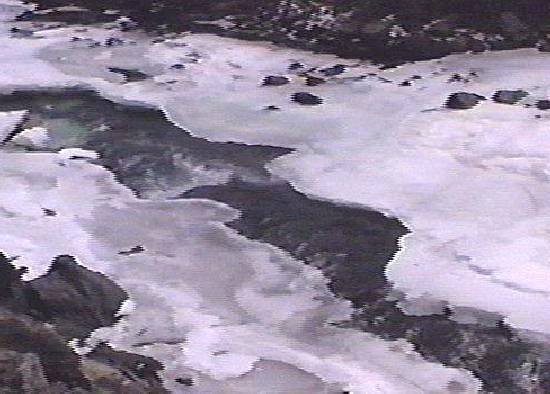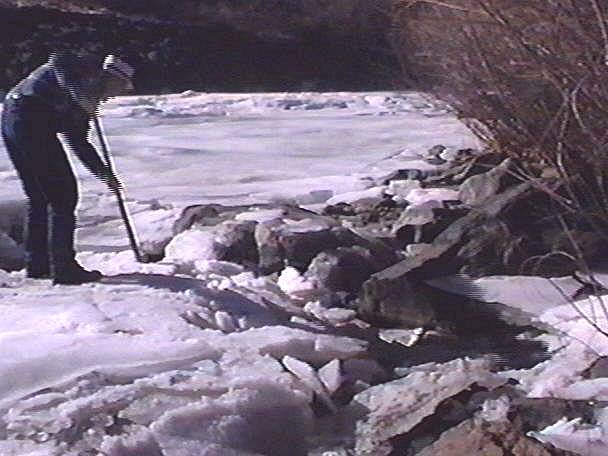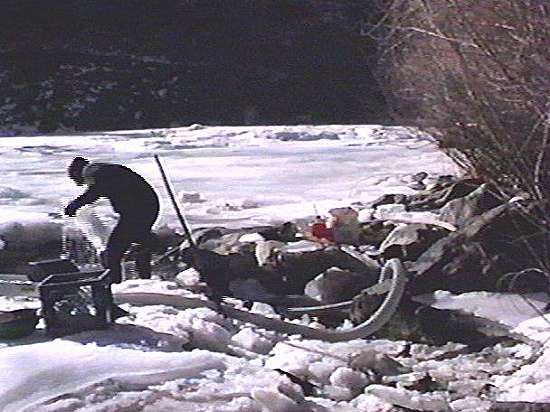Winter Dredging in Clear Creek, Colorado
Sometimes the "urge to dredge" outweighs common sense and an
expedition is planned even though the conditions aren't optimal. In Colorado the gold
prospectors begin to experience cabin fever in about January. New toys may have been
received for Christmas and there is an eagerness to try them out. Unfortunately, this
isn't the best time of year in Colorado to dredge, but where there is a will, there is a
way. These pictures were taken January 19th and 20th, 1997. Sorry about the quality of
some of the pictures. The video camera doesn't like the cold weather. Maybe that should be
a hint to the gold prospectors.
 This is Clear Creek about 15 miles
upstream from Denver, Co. In the summer it is almost lined with gold panners searching for
their fortunes. At this time of year much of it is completely frozen over and you can have
your pick of almost any spot. The few spots with no ice are the result of swift water
current and they aren't the best place to dredge. As a result of this problem, the spot
selected to dredge should be chosen very scientifically using the following parameters.
This is Clear Creek about 15 miles
upstream from Denver, Co. In the summer it is almost lined with gold panners searching for
their fortunes. At this time of year much of it is completely frozen over and you can have
your pick of almost any spot. The few spots with no ice are the result of swift water
current and they aren't the best place to dredge. As a result of this problem, the spot
selected to dredge should be chosen very scientifically using the following parameters.
- The ice shouldn't be more than 4 or 5" thick.
- The site should be selected using time proven scientific methods like behind a
big rock or on an inside corner.
- The most important factor. It should in the sunshine.
- It helps if the spot isn't visible from the road so the men in white coats won't
come after you.
 Once the magic spot is selected, the real work begins. Getting
to the water. Here a steel bar is being used to break a hole in the 3" thick ice on
the downstream side of a large rock on the inside corner of the stream in the sun. Life is
good. A floating dredge isn't very practical for winter dredging. The ice hole would have
to be a lot larger. I have a 2 1/2" dredge and it is just about the right size for
one person to move around and setup easily. Usually only a few hours will be spent in the
water. Not enough to go through the setup required for a large dredge. You might find this
hard to believe but sometimes I have trouble finding someone to go dredging with in the
winter.
Once the magic spot is selected, the real work begins. Getting
to the water. Here a steel bar is being used to break a hole in the 3" thick ice on
the downstream side of a large rock on the inside corner of the stream in the sun. Life is
good. A floating dredge isn't very practical for winter dredging. The ice hole would have
to be a lot larger. I have a 2 1/2" dredge and it is just about the right size for
one person to move around and setup easily. Usually only a few hours will be spent in the
water. Not enough to go through the setup required for a large dredge. You might find this
hard to believe but sometimes I have trouble finding someone to go dredging with in the
winter.
 Winter requires dealing with
"white rocks". The type more commonly put into drinks. After breaking the ice
out of the hole it must be thrown out. Here a large 3 foot piece of ice is being removed.
The water temperature this day was measured at 27 degrees. No bare hand work is done. A
wet suit is required. Notice the blue milk box in the foreground. These work very well
when using a small dredge. The rocks too large for the hose ( that's a lot when using a
small dredge ) are placed into the box instead of throwing them. This saves the arm when
putting in a full day on the nozzle. When the box is full carry it to a clear spot and
dump it. A metal one would work better than the plastic as the plastic will float until
some rocks are placed in it.
Winter requires dealing with
"white rocks". The type more commonly put into drinks. After breaking the ice
out of the hole it must be thrown out. Here a large 3 foot piece of ice is being removed.
The water temperature this day was measured at 27 degrees. No bare hand work is done. A
wet suit is required. Notice the blue milk box in the foreground. These work very well
when using a small dredge. The rocks too large for the hose ( that's a lot when using a
small dredge ) are placed into the box instead of throwing them. This saves the arm when
putting in a full day on the nozzle. When the box is full carry it to a clear spot and
dump it. A metal one would work better than the plastic as the plastic will float until
some rocks are placed in it.
Clear Creek January dredging page 2
Menu
 This is Clear Creek about 15 miles
upstream from Denver, Co. In the summer it is almost lined with gold panners searching for
their fortunes. At this time of year much of it is completely frozen over and you can have
your pick of almost any spot. The few spots with no ice are the result of swift water
current and they aren't the best place to dredge. As a result of this problem, the spot
selected to dredge should be chosen very scientifically using the following parameters.
This is Clear Creek about 15 miles
upstream from Denver, Co. In the summer it is almost lined with gold panners searching for
their fortunes. At this time of year much of it is completely frozen over and you can have
your pick of almost any spot. The few spots with no ice are the result of swift water
current and they aren't the best place to dredge. As a result of this problem, the spot
selected to dredge should be chosen very scientifically using the following parameters.
 Once the magic spot is selected, the real work begins. Getting
to the water. Here a steel bar is being used to break a hole in the 3" thick ice on
the downstream side of a large rock on the inside corner of the stream in the sun. Life is
good. A floating dredge isn't very practical for winter dredging. The ice hole would have
to be a lot larger. I have a 2 1/2" dredge and it is just about the right size for
one person to move around and setup easily. Usually only a few hours will be spent in the
water. Not enough to go through the setup required for a large dredge. You might find this
hard to believe but sometimes I have trouble finding someone to go dredging with in the
winter.
Once the magic spot is selected, the real work begins. Getting
to the water. Here a steel bar is being used to break a hole in the 3" thick ice on
the downstream side of a large rock on the inside corner of the stream in the sun. Life is
good. A floating dredge isn't very practical for winter dredging. The ice hole would have
to be a lot larger. I have a 2 1/2" dredge and it is just about the right size for
one person to move around and setup easily. Usually only a few hours will be spent in the
water. Not enough to go through the setup required for a large dredge. You might find this
hard to believe but sometimes I have trouble finding someone to go dredging with in the
winter. Winter requires dealing with
"white rocks". The type more commonly put into drinks. After breaking the ice
out of the hole it must be thrown out. Here a large 3 foot piece of ice is being removed.
The water temperature this day was measured at 27 degrees. No bare hand work is done. A
wet suit is required. Notice the blue milk box in the foreground. These work very well
when using a small dredge. The rocks too large for the hose ( that's a lot when using a
small dredge ) are placed into the box instead of throwing them. This saves the arm when
putting in a full day on the nozzle. When the box is full carry it to a clear spot and
dump it. A metal one would work better than the plastic as the plastic will float until
some rocks are placed in it.
Winter requires dealing with
"white rocks". The type more commonly put into drinks. After breaking the ice
out of the hole it must be thrown out. Here a large 3 foot piece of ice is being removed.
The water temperature this day was measured at 27 degrees. No bare hand work is done. A
wet suit is required. Notice the blue milk box in the foreground. These work very well
when using a small dredge. The rocks too large for the hose ( that's a lot when using a
small dredge ) are placed into the box instead of throwing them. This saves the arm when
putting in a full day on the nozzle. When the box is full carry it to a clear spot and
dump it. A metal one would work better than the plastic as the plastic will float until
some rocks are placed in it.